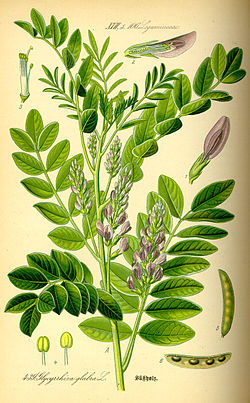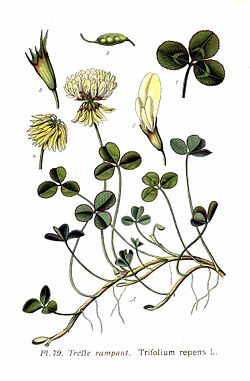An inverted repeat (or IR) is a single stranded sequence of nucleotides followed downstream by its reverse complement. The intervening sequence of nucleotides...
31 KB (3,451 words) - 17:17, 28 May 2025
Repeated sequence (DNA) (redirect from Dna repeat)
nucleotides separating the inverted repeat, such as "CATCATATGATG", the sequence is called a palindromic repeat. Inverted repeats can play structural roles...
32 KB (3,832 words) - 20:58, 13 April 2025
cruciform DNA requires the presence of palindromes called inverted repeat sequences. These inverted repeats contain a sequence of DNA in one strand that is repeated...
28 KB (3,447 words) - 16:00, 30 March 2024
Miniature Inverted-repeat Transposable Elements (MITEs) are a group of non-autonomous Class II transposable elements (DNA sequences). Being non-autonomous...
11 KB (1,374 words) - 20:02, 24 September 2023
unique short (US), as well as terminal inverted repeats found to the two ends of them named repeat long (RL) and repeat short (RS). There are also minor "terminal...
69 KB (7,536 words) - 10:08, 3 June 2025
The inverted repeat-lacking clade (IRLC) is an informal monophyletic clade of the flowering plant subfamily Faboideae. Well-known members of this clade...
10 KB (912 words) - 07:55, 2 May 2025
Chloroplast DNA (section Inverted repeats)
have since lost the inverted repeats. Others, like the red alga Porphyra flipped one of its inverted repeats (making them direct repeats). It is possible...
54 KB (5,889 words) - 18:07, 23 May 2025
subdivisions of the plant family Fabaceae. It is included within the inverted repeat-lacking clade (IRLC). All of the members of this tribe are trifoliate...
2 KB (126 words) - 20:39, 17 March 2024
identified by short direct repeats (a staggered cut in the target DNA filled by DNA polymerase) followed by inverted repeats (which are important for the...
43 KB (5,418 words) - 22:28, 7 June 2025
have since lost or flipped the inverted repeats (making them direct repeats). It is possible that the inverted repeats help stabilize the rest of the...
193 KB (19,591 words) - 04:33, 2 June 2025
pollicaris, was shown to have a family of AT-rich satellites with inverted repeat structures that comprised 30% of the entire genome. Another cryptic...
15 KB (1,817 words) - 22:47, 24 January 2025
through exon shuffling.[citation needed] DNA transposon with Terminal inverted repeats (TIRs) can also contribute to gene shuffling. In plants, some non-autonomous...
18 KB (2,249 words) - 07:08, 22 February 2024
refers to two areas of a DNA strand whose base pair sequences are inverted repeats of each other. They are often described as palindromes. For example...
2 KB (175 words) - 17:42, 11 May 2020
Rosids Order: Fabales Family: Fabaceae Subfamily: Faboideae Clade: Inverted repeat-lacking clade Genus: Glycyrrhiza Species: G. glabra Binomial name Glycyrrhiza...
22 KB (2,287 words) - 21:20, 29 May 2025
therefore regulate transcription. The sequence is most commonly a pair of inverted repeats separated by three nucleotides, which also indicates that the receptor...
5 KB (453 words) - 22:54, 3 April 2025
subdivisions of the plant family Fabaceae. It is included within the Inverted repeat-lacking clade (IRLC). Five genera are included: Lathyrus L. (vetchlings)...
2 KB (157 words) - 05:31, 22 November 2024
plastid genomes differing in gene content, order and expansion of the inverted repeat. The name Pelargonium was first proposed by Dillenius in 1732, who...
76 KB (7,650 words) - 18:28, 17 June 2025
saguaro cactus (Carnegiea gigantea): Loss of the ndh gene suite and inverted repeat". American Journal of Botany. 102 (7): 1115–1127. doi:10.3732/ajb.1500184...
54 KB (5,819 words) - 20:28, 15 June 2025
replication (Sherratt 1989). The transposon is flanked by a pair of 38bp inverted repeats. This first stage is catalysed by transposase. The plasmid containing...
9 KB (1,222 words) - 05:04, 20 July 2024
The tribe belongs to the Inverted repeat-lacking clade; all genera lack one 25 kilobase long copy of the inverted repeat in the chloroplast genome,...
7 KB (540 words) - 05:28, 22 November 2024
Rosids Order: Fabales Family: Fabaceae Subfamily: Faboideae Clade: Inverted repeat-lacking clade Tribe: Fabeae Genus: Lathyrus L. (1753), nom. cons. Species...
17 KB (1,393 words) - 18:22, 25 May 2025
radiology and interventional radiologist, an independent medical specialty Inverted repeat, a sequence of nucleotides that is the reversed complement of another...
5 KB (575 words) - 17:13, 10 November 2024
tandem repeats being more common than inverted repeats (which may interfere with DNA replication). VNTRs are the class of clustered tandem repeats that...
8 KB (822 words) - 23:20, 3 April 2025
by a pair of inverted repeats (terminal/internal repeat long TRL/IRL and internal/terminal repeat short IRS/TRS). Both sets of repeats share a region...
15 KB (1,370 words) - 03:10, 5 February 2025
Rosids Order: Fabales Family: Fabaceae Subfamily: Faboideae Clade: Inverted repeat-lacking clade Tribe: Trifolieae Genus: Trigonella L. Species See text...
8 KB (464 words) - 18:06, 15 October 2023
Rosids Order: Fabales Family: Fabaceae Subfamily: Faboideae Clade: Inverted repeat-lacking clade Tribe: Trifolieae Genus: Trifolium L. Subgenera and sections...
37 KB (3,173 words) - 18:20, 26 May 2025
housekeeping genes and apparently involves the secondary gain of a large inverted repeat". Genome Biology and Evolution. 11 (10): 2789–2796. doi:10.1093/gbe/evz187...
96 KB (8,120 words) - 19:01, 6 April 2025
Unstable DNA sequence (section Inverted repeats)
between individuals, they have been utilized in DNA fingerprinting. Inverted repeats are specific DNA sequences in which the nucleotide sequence on one...
20 KB (2,187 words) - 06:05, 28 May 2025
Rosids Order: Fabales Family: Fabaceae Subfamily: Faboideae Clade: Inverted repeat-lacking clade Genus: Glycyrrhiza L. Synonyms Clidanthera R.Br. (1849)...
3 KB (193 words) - 02:58, 5 March 2024
site: where the unwound plasmid DNA is cut; usually site-specific. An inverted repeat sequence: signals the end of replication of donor DNA and is responsible...
16 KB (1,782 words) - 21:36, 23 May 2025


















